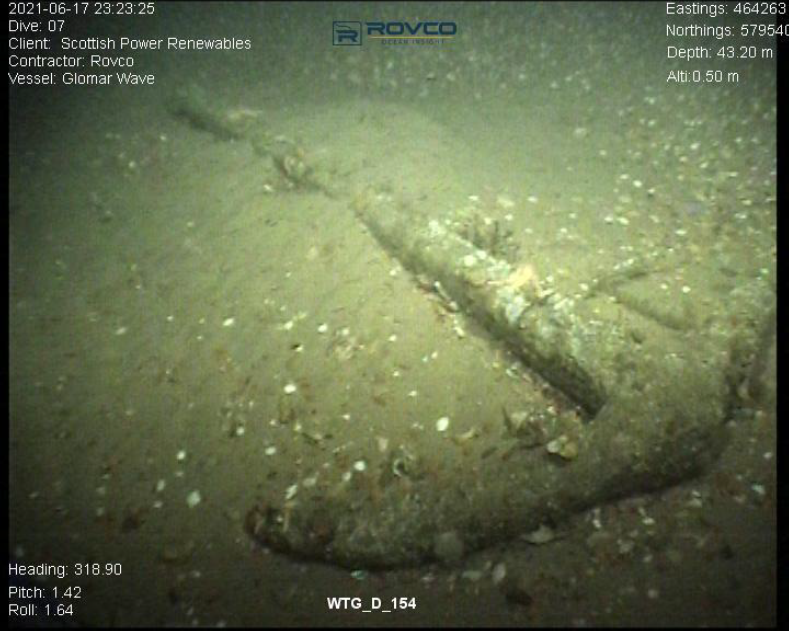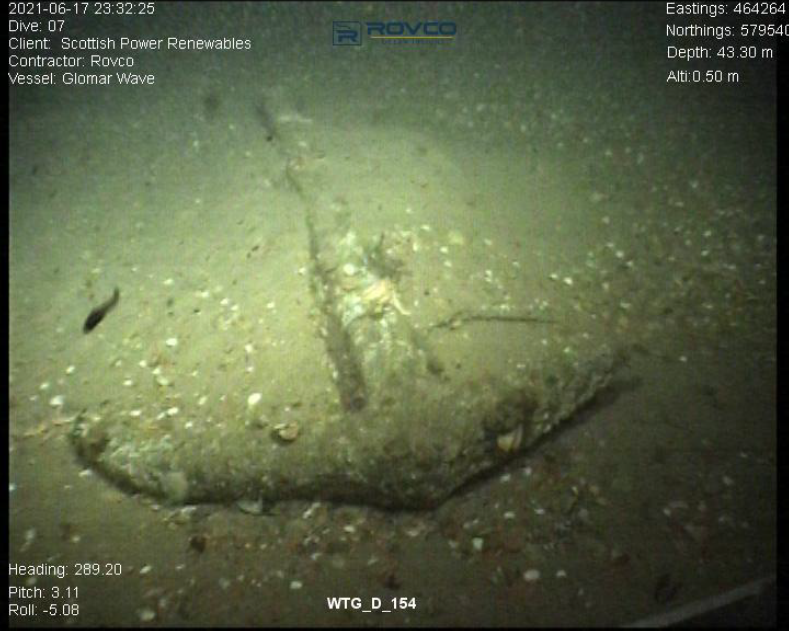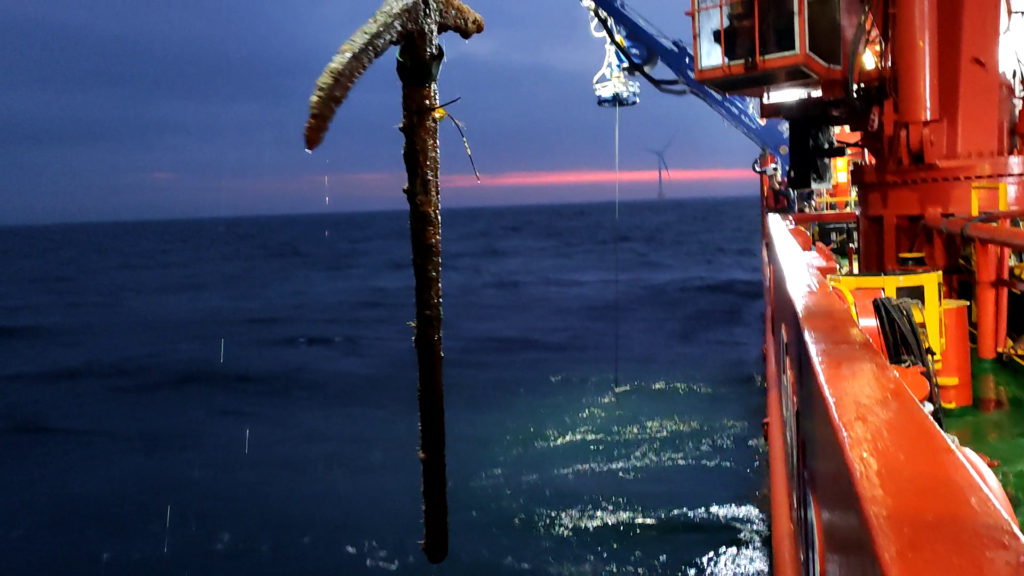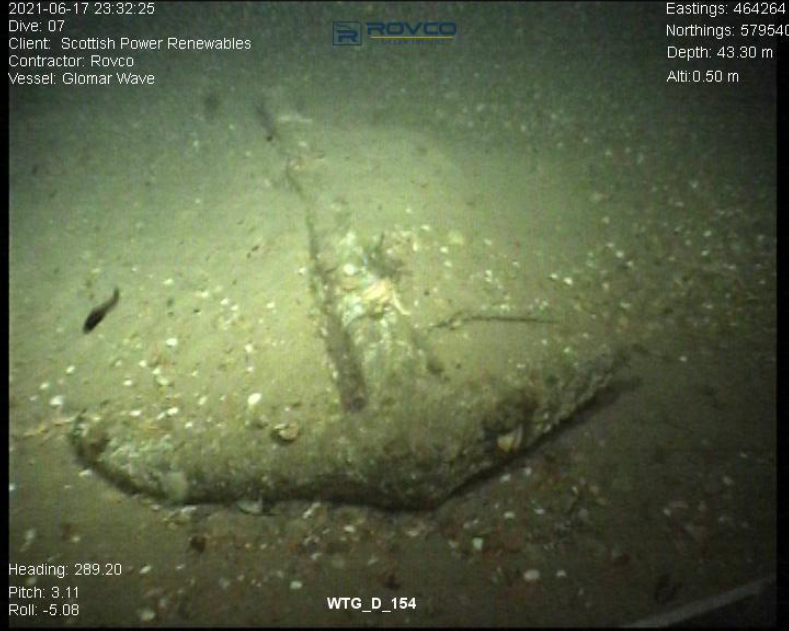The underwater discovery of a distinctive wrought iron anchor found at the bottom of the southern North Sea during survey works for ScottishPower Renewables’ East Anglia ONE offshore windfarm has been hailed as an “incredibly rare” find.
Believed to be a rare example from the Roman or possibly late Iron Age – somewhere between 1,600-2,000 years old – the anchor could provide material evidence of ancient Romans seafaring and trading in the southern North Sea, off the coast of the East of England.
More than 2 metres long and weighing in at around 100kg, the anchor is estimated to have come from a 500-600 tonnes vessel. If dated to the time of the Roman occupation of Britain, it’s most likely to have come from one of the larger merchant ships of the Roman fleet.
While analytical work is ongoing to confirm the date, there are several features that suggest the anchor could come from the Imperial Roman period.

The Classis Britannica was the regional fleet of the Roman province of Britannia and the first navy of Britain. Although very little physical maritime evidence has been discovered, it operated from the mid-first century to the mid-third century and employed merchant vessels to transport foodstuffs, troops, horses and war machinery such as catapults and rams.
The anchor was first discovered in 2018 thanks to marine seabed survey works being undertaken by ScottishPower Renewables prior to the construction of its East Anglia ONE offshore windfarm, located around 40km off the coast of Suffolk.
Protected by an exclusion zone installed on the seabed during the construction works and monitored using remote underwater technology due to concerns over its long-term preservation, the anchor was safely and carefully recovered from the water in 2021.
It is currently undergoing detailed imaging and analysis to better pinpoint its age and provenance. Once complete, this will allow the anchor to go on permanent display in conjunction with Colchester + Ipswich Museums.
The conservation works are being carried out by ScottishPower Renewables’ commissioned specialists Maritime Archaeology Ltd, in conjunction with the Mary Rose Archaeological Services, and with advice and guidance throughout the process from Historic England’s material science experts.
Brandon Mason from Maritime Archaeology Ltd spent hours monitoring the anchor while it lay at the bottom of the sea. He was on board the Glomar Wave when the anchor was brought more than 140 feet to the surface and transported to shore.
He said: “Everything points to this being a Roman anchor of almost 2,000 years old, which is an incredibly rare piece of history. If this date is confirmed, it would be hard to overstate its significance – we only know about three pre-Viking anchors from northern European waters outside the Mediterranean region and only two actually survived.
“We believe this find could be the oldest and one of the largest surviving examples, giving us hard evidence of the incredible amount of activity that must have been going on in the waters in Roman times, but that we know relatively little about. It’s an absolute privilege to bring the anchor to the surface and to share its story with people not just across the East of England, but right around the world.
“I look forward to seeing it on permanent display once the conservation work and analysis has been completed and thank ScottishPower Renewables for taking the time to find and preserve such an important piece of history while developing its windfarm.”

The anchor is the latest in a series of important historical and archaeological finds during the work on the award-winning East Anglia ONE windfarm: These include:
- A missing German submarine from the First World War discovered during seabed scanning activity almost 100 years after it disappeared while on patrol.
- Numerous artefacts from the Bronze Age, Iron Age, Roman and Medieval periods discovered during onshore excavation works across more than 50 dig sites.
- A prehistoric monument – dating back more than 4,000 years – complete with a rare Neolithic wooden trackway and platform and an ancient wild cattle (Auroch) skull radiocarbon-dating to around over 6,000 years old, discovered as part of the works, which formed one of Europe’s largest archaeological digs in recent years.
Ross Ovens, ScottishPower Renewables’ Managing Director – East Anglia Hub, said: “Our East Anglia ONE windfarm has proven to be an archaeological treasure trove – both onshore and offshore – and this latest find shows that it just keeps giving.
“As part of the Iberdrola Group, we pride ourselves on the sensitive way in which we approach our offshore projects across the world to ensure that their environment and heritage are protected and preserved and it’s fascinating to see what that means in practice. The East Anglia ONE finds will tell us so much not just about East Anglia’s history itself, but also the region’s place in British history.
“This is very much the icing on the cake when we consider the obvious benefits of East Anglia ONE – clean, green electricity for hundreds of thousands of homes; massive regional investment that put multi-million sums into the hands of local businesses and suppliers while supporting thousands of jobs; and a successful skills and education programme that included the creation of our first offshore apprentice programme. That’s a brilliant track record.
“The anchor recovery has been a real team effort. My thanks to everyone involved for their dedication to protecting and raising this amazing piece of maritime and social history. I can’t wait to see what more we can find out about it – or what else we might find! Regardless of what is still to come, it’s clear East Anglia ONE has already anchored its place in maritime history and we’re very proud of that.”

The archaeological works linked to East Anglia ONE – including the anchor recovery – were overseen and supported by Historic England, which helps people care for, enjoy and celebrate England’s historic environment.
Stuart Churchley, Historic England Marine Planning Archaeological Officer, said: “The discovery of such a potentially significant anchor of this date, among the vast seafloor expanse of the southern North Sea, is testament to the careful and methodical steps taken by the East Anglia ONE project. This area of the North Sea has been mapped and investigated in a way not completed before.
“For the anchor, the resulting analysis and conservation is an important next stage. For this reason, ScottishPower Renewables is commissioning a process of analysis to explore the material form of the anchor. Historic England’s material science experts have been providing guidance on this element of work, with some of the techniques not used before. It will be great to see the plans for it to be exhibited locally come to fruition.”
Councillor Carole Jones, Ipswich Borough Council Portfolio Holder for Ipswich Museums, said: “We are very pleased to have the opportunity to bring such a historic find to Ipswich and add it to our wonderful collection.
“The anchor will only be available for our visitors to get a first peek on Tuesday 27 September, before it is taken away for key conservation work ahead of returning permanently to our collection in 2025.”

